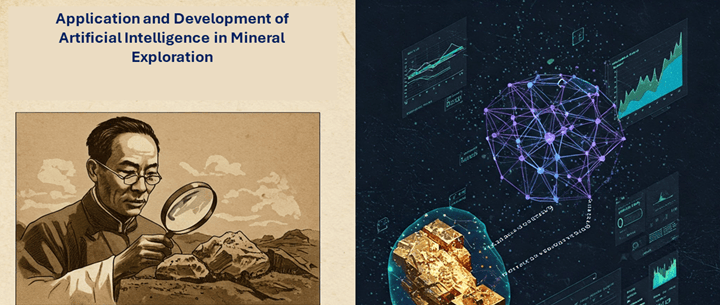Application and Development of Artificial Intelligence in Mineral Exploration
Xuan-Ce Wang
4/21/20254 min read


Introduction
Currently, artificial intelligence (AI) technology is profoundly transforming the global mineral resource exploration and development landscape, emerging as a "super trend" in technological innovation. Amid unprecedented global shifts over the past century and the thriving evolution of a new wave of technological and industrial revolutions, AI stands as a new quality productive force, comprehensively reshaping the global mineral resource development model and delivering remarkable results in practical applications. This report provides a comprehensive analysis of AI's role in mineral exploration, covering its technical principles and applications, primary application areas, technical examples and success stories, leading enterprises and research institutions, as well as future prospects and challenges.
Technical Principles and Applications of AI in Mineral Exploration
Basic Principles and Application Scenarios
Artificial intelligence (AI) focuses on researching and developing theories, methods, and technologies to simulate and enhance human intelligence. It spans diverse fields such as robotics, language and image recognition, and computer vision sensing systems. At its core, AI leverages large-scale data models to perform statistical analysis on vast datasets, enabling it to summarize, memorize, and draw conclusions, mimicking human-like intelligent responses.
Mineral exploration is fundamentally a process of data collection and knowledge-driven analysis. Traditionally, geologists gather information through various methods and analyze it using expert knowledge. AI revolutionizes this process by introducing automated and intelligent systems. Its key advantages include:
Data Processing Capability: AI rapidly analyzes geological surveys, satellite imagery, and historical exploration data to create visualized geological mine models.
Pattern Recognition Capability: Using machine learning models like neural networks, AI identifies patterns, anomalies, and potential mineral deposits that traditional methods often miss.
Integrated Analysis Capability: AI integrates multi-source, multi-scale geological data for comprehensive, cross-disciplinary analysis.
These strengths make AI an essential tool in mineral exploration, significantly boosting both efficiency and accuracy.
Main Application Areas
AI's applications in the mining industry are increasingly widespread, encompassing the following key areas:
Mineral Exploration: AI systems predict the location and scale of underground deposits by analyzing geological anomalies and mineralization features.
Mine Production: AI-powered sorting systems identify valuable minerals in waste rock in real time, enhancing resource recovery and utilization rates.
Data and Image Processing: AI efficiently handles tasks like data classification, summarization, and feature extraction—e.g., three-dimensional inversion of geophysical data and automated geological mapping from high-resolution remote sensing images.
Geological Disaster Warning: Combined with remote sensing and IoT devices, AI monitors geological environmental changes in real time, forecasting natural disasters such as earthquakes and landslides.
These applications highlight AI's transformative potential across the mining value chain, from exploration and production to safety management.
Technical Examples and Success Stories
Key Technology Platforms
Earth AI’s "Mineral Targeting Platform". Regarded as one of the industry’s most accurate prediction tools, this platform boosts mineral discovery success rates from a traditional 0.5% to 66%. It leverages around 400 million Australian geological cases and 50 years of historical data to train AI models, replicating and expanding geologists' reasoning. Earth AI also developed proprietary drilling technology, shrinking boreholes to tennis-ball size, reducing environmental impact and exploration costs.
KoBold Metals’ AI Exploration System. Backed by investors like Bill Gates and Jeff Bezos, this company uses AI to process and analyze geological data, successfully pinpointing high-potential mining zones.
Norwegian Tomra’s Ore Sorting System. Tomra integrates sensors and AI to create intelligent sorting systems tailored to various minerals, improving ore sorting efficiency.
BHP and Microsoft’s AI System. BHP collaborates with Microsoft to optimize the Escondida copper mine’s production process using AI and machine learning, enhancing copper recovery rates.
Successful Discovery Cases
Fontenoy Project Palladium Mine Discovery. Earth AI uncovered one of Australia’s largest palladium mines in New South Wales, alongside nearby platinum and nickel deposits. This marked AI’s first breakthrough in "greenfield" (undeveloped) areas and the initial discovery of magmatic nickel, copper, and platinum group elements on Australia’s east coast.
Willow Glen Gold Mine Project. In December 2024, Earth AI identified a new gold mining system in Australia’s Willow Glen molybdenum-gold project, underscoring AI’s vast potential in gold exploration.
Mingomba Copper Mine Discovery. KoBold Metals used AI to discover the high-grade, high-reserve Mingomba copper deposit in Zambia, affirming AI’s practical value in mineral exploration.
These examples demonstrate AI’s ability to enhance discovery efficiency and unlock critical mineral resources.
Leading Enterprises and Research Institutions
Leading Enterprises
Earth AI. This U.S.-based company specializes in new energy mineral exploration. Its "Mineral Targeting Platform" achieves a 66% discovery success rate. By integrating big data training with proprietary drilling tech, it cuts exploration costs to 50% of traditional methods and shortens timelines significantly.
KoBold Metals. Supported by prominent investors, this firm focuses on AI-driven discovery of critical minerals, achieving success with large copper deposits in Zambia.
Other Startups. Nearly 100 global AI mineral exploration startups—like Ver AI, Plotlogic, Geologic AI, and Ideon Technologies—each bring unique innovations, collectively advancing the industry.
AI Transformation of Traditional Mining Companies. BHP partners with Microsoft to streamline production, while Norway’s Tomra develops AI sorting systems. Traditional mining giants are actively adopting AI technologies.
Development Prospects and Challenges
Development Trends
Booming Industry: Globally, companies leveraging AI for mineral exploration are multiplying, with startups leading innovation breakthroughs.
Clean Energy Demand: As clean energy transitions accelerate, demand for critical minerals like palladium, platinum, and nickel rises, with AI poised to uncover more resources.
Technology Integration: AI’s fusion with remote sensing, IoT, and automation will drive the evolution of intelligent mining ecosystems.
Challenges
Data Quality and Standardization: The quality, consistency, and accessibility of geological data remain critical bottlenecks for precise AI predictions.
Technical Interpretability: The "black box" nature of AI models requires improvement to build trust among geological experts.
Talent Shortage: Experts proficient in both geology and AI are scarce.
Regulatory Adaptability: Current mining regulations need updates to accommodate AI-driven changes.
Conclusion
Artificial intelligence is breathing new life into traditional mining, revolutionizing mineral exploration and development. From Earth AI’s palladium discovery in Australia to KoBold Metals’ copper find in Zambia, AI has proven its real-world value. As global demand for new energy metals and critical minerals grows, AI’s role in mining will deepen further.
Despite challenges like data quality and model interpretability, the fusion of AI and mining is an unstoppable trend. Looking ahead, as technologies mature and applications expand, AI will emerge as a core driver, propelling the global mining industry toward intelligence, efficiency, and sustainability—unleashing an "intelligent storm" in the sector.
Citations
[1] https://www.thepaper.cn/newsDetail_forward_29118805
[2] https://finance.sina.com.cn/cj/2025-02-26/doc-inemvssw7694543.shtml








